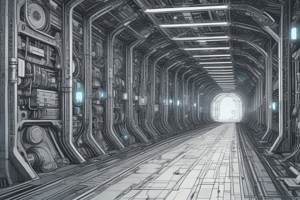Podcast
Questions and Answers
What is the main objective of requirements engineering processes?
What is the main objective of requirements engineering processes?
- To implement a system that meets customer needs
- To test a system to ensure it meets customer requirements
- To design a system that meets customer requirements
- To establish the services that the customer requires from a system and the constraints under which it operates and is developed (correct)
What is requirements elicitation and analysis?
What is requirements elicitation and analysis?
- A type of system modeling
- The process of establishing the services that the customer requires from a system and the constraints under which it operates and is developed
- The process of checking if the system provides the functions which best support the customer's needs
- A generic activity common to all processes (correct)
What is the primary focus of requirements engineering?
What is the primary focus of requirements engineering?
- Developing tests for requirements
- Eliciting and analyzing stakeholder needs (correct)
- Validating the system design
- Implementing the system architecture
What is the purpose of requirements validation?
What is the purpose of requirements validation?
What is the significance of unambiguous requirements?
What is the significance of unambiguous requirements?
What is the purpose of requirements management?
What is the purpose of requirements management?
What is system modeling?
What is system modeling?
Which phase of requirements engineering involves developing models of the system?
Which phase of requirements engineering involves developing models of the system?
What is the primary goal of requirements management?
What is the primary goal of requirements management?
What is the purpose of interaction models?
What is the purpose of interaction models?
What is the purpose of requirements reviews?
What is the purpose of requirements reviews?
What is the primary benefit of having verifiable requirements?
What is the primary benefit of having verifiable requirements?
What is the purpose of requirements elicitation and analysis?
What is the purpose of requirements elicitation and analysis?
What is prototyping in requirements engineering?
What is prototyping in requirements engineering?
What is the primary benefit of having consistent requirements?
What is the primary benefit of having consistent requirements?
What is the primary role of system modeling in requirements engineering?
What is the primary role of system modeling in requirements engineering?
What is the primary purpose of context models in system modeling?
What is the primary purpose of context models in system modeling?
Which type of model is used to illustrate the interactions between a system and its environment?
Which type of model is used to illustrate the interactions between a system and its environment?
What is the primary benefit of modeling inner aspects of a system?
What is the primary benefit of modeling inner aspects of a system?
What does an actor in a use case represent?
What does an actor in a use case represent?
Which type of model is used to illustrate the internal structure of a system?
Which type of model is used to illustrate the internal structure of a system?
What is the purpose of use cases in system modeling?
What is the purpose of use cases in system modeling?
What type of model is used to show the dynamic behavior of a system?
What type of model is used to show the dynamic behavior of a system?
What is the relationship between a medical receptionist and a patient record system in the Mentcare system?
What is the relationship between a medical receptionist and a patient record system in the Mentcare system?
Study Notes
Requirements Engineering
- Establishes the services that the customer requires from a system and the constraints under which it operates and is developed
- Involves iterative activities: requirements elicitation and analysis, requirements validation, and requirements management
Requirements Elicitation and Analysis
- Determines the actual needs of stakeholders
- Identifies the services required by the customer
- Defines the constraints within which the system operates
Requirements Validation
- Checks that the system provides the functions that best support the customer's needs
- Verifies consistency, completeness, and feasibility of requirements
- Ensures requirements can be tested and validated
Requirements Management
- Manages changing requirements during system development and after deployment
- Keeps track of individual requirements and maintains links between dependent requirements
- Establishes a formal process for making change proposals and linking them to system requirements
System Modeling
- Develops models of a system from different perspectives: external, interaction, structural, and behavioral
- Uses graphical notations, typically UML, to represent the system
- Helps analysts understand the system's functionality and communicate with customers
System Modeling Perspectives
- External perspective: models the system's context and environment
- Interaction perspective: models interactions between the system and its environment, or between system components
- Structural perspective: models the system's architecture and components
- Behavioral perspective: models the system's dynamic behavior and response to events
Use Cases
- Developed to support requirements elicitation
- Represents a discrete task involving external interaction with a system
- Each use case involves actors (people or systems) and can be represented diagrammatically or in a detailed textual form
Studying That Suits You
Use AI to generate personalized quizzes and flashcards to suit your learning preferences.
Description
This quiz covers the concepts of requirements engineering processes, including requirements specification, validation, and management, as well as system modeling and interaction models.




